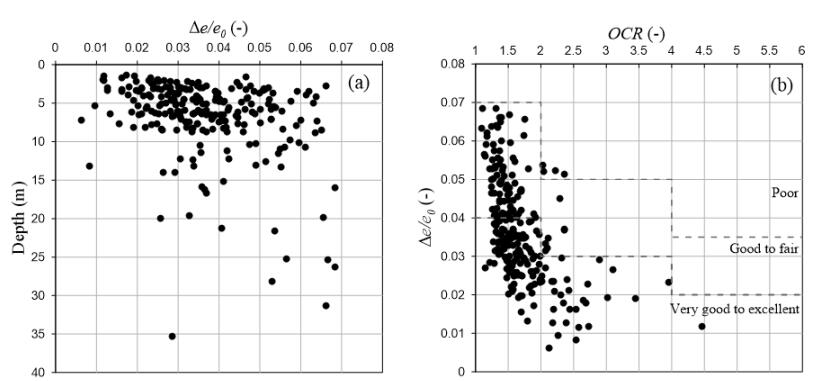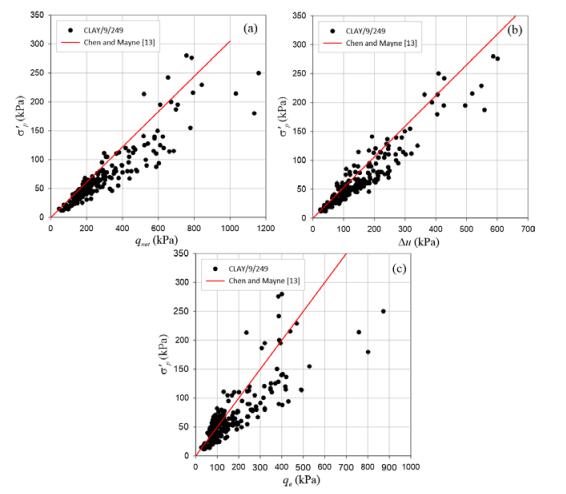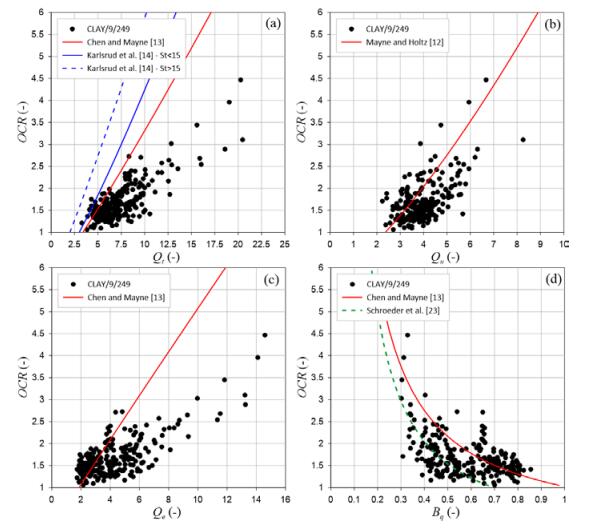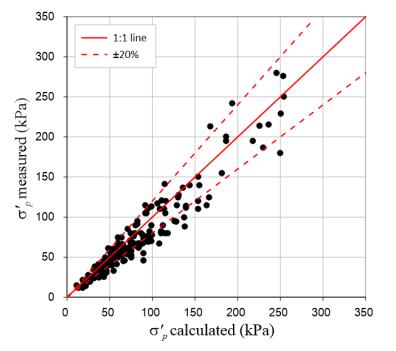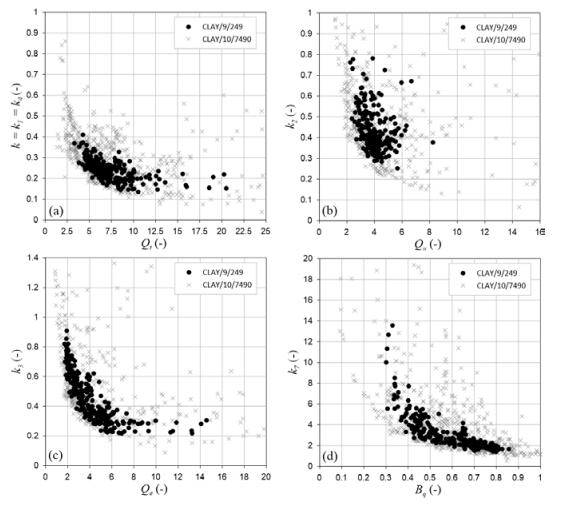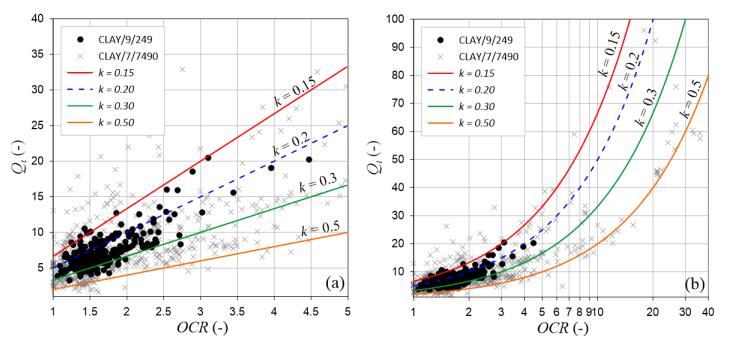An extensive database of high-quality piezocone (CPTU) and laboratory oedometer test data on onshore and offshore clays worldwide has been established. The database covers a wide range of index parameters and overconsolidation ratios (OCR) in the range 1 to 5. The purpose is to derive general correlations to model preconsolidation stress in clays from CPTU data based on high-quality laboratory data. Several studies have already discussed such correlations for different clay types, where the preconsolidation stress is defined as a function of the cone resistance and/or the pore pressure measured in CPTU tests. Often, these correlations are characterized by high uncertainty, mainly because of the sample quality of the laboratory data. New correlations are proposed based on the new database. These correlations are meant to be used for preliminary assessment of preconsolidation stress in the absence of laboratory data or as a comparison tool when limited test data is available.
1.
Introduction
The Skinner–Rusk formalism was introduced by R. Skinner and R. Rusk in 1983 [1] (although a previous description in local coordinates had been developed by K. Kamimura in [2]) in order to deal with mechanical systems described by singular Lagrangian functions. This formulation combines both the Lagrangian and Hamiltonian formalism and this is why it is sometimes called unified formalism. The Skinner–Rusk formalism has been extended to time-dependent systems [3,4,5], nonholonomic and vakonomic mechanics [6], higher-order mechanical systems [7,8,9,10], control systems [11,12] and field theory [13,14,15,16,17,18]. Recently, the Skinner–Rusk unified formalism was extended to contact [19] and k-contact [20] systems. The Skinner–Rusk unified formalism has several advantages. In first place, we recover the second-order condition even if the Lagrangian of the system is singular. We also recover the definition of the Legendre map from the constraint algorithm. Also, both the Lagrangian and Hamiltonian formulations can be recovered from the Skinner–Rusk formalism by projecting onto their respective phase spaces.
The use of contact geometry [21,22,23] to model geometrically the time-dependence in mechanical systems is very well-known [24,25,26] and it is, alongside with cosymplectic geometry [27], the natural way to do it. However, in the last decade, the application of contact geometry to the study of dynamical systems has grown significantly [28,29]. This is due to the fact that one can use contact structures to describe many different types of dynamical systems which cannot be described by means of symplectic geometry and standard Hamiltonian dynamics in a natural way. The dynamical systems which can be modelled using contact structures include mechanical systems with certain types of damping [30,31,32], some systems in quantum mechanics [33], circuit theory [34], control theory [35] and thermodynamics [36,37], among many others [23,25,38,39,40,41,42,43].
Although contact geometry is a suitable framework when working with systems of ordinary differential equations, a generalisation is required in order to deal with systems of partial differential equations describing classical field theories. This generalisation is the so-called k-contact structure [20,44,45]. This formulation allows to describe many types of field theories both in the Lagrangian and in the Hamiltonian formalisms. The k-contact framework allows us to describe geometrically field theories with damping, some equations from circuit theory, such as the so-called telegrapher's equation, or the Burgers' equation. Recently, a geometric framework has been developed [46] in order to deal with time-dependent mechanical systems with dissipation using the so-called cocontact geometry. It is still an open problem to find a geometric setting to describe non-autonomous field theories with damping.
The main goal of this paper is to extend the Skinner–Rusk formalism to time-dependent contact systems, studying the dynamical equations and the submanifold where they are consistent, and showing that the Lagrangian and Hamiltonian formalisms can be recovered from this mixed formalism. In first place, we introduce the phase space of this formulation: the Pontryagin bundle W=R×TQ×T∗Q×R endowed with natural coordinates (t,qi,vi,pi,s). This manifold has a natural precocontact structure (dt,η) inherited from the natural cocontact structure of R×T∗Q×R (see [46]). The Hamiltonian function associated to a Lagrangian function L∈C∞(R×TQ×R) is defined as
Since the Hamiltonian system (W,dt,η,H) is singular, we need to implement a constraint algorithm in order to find a submanifold where the Hamiltonian equations are consistent. In the first iteration of the constraint algorithm we recover the second-order condition, even if the Lagrangian function is singular (in the Lagrangian formalism, we only recover the SODE condition if the Lagrangian is regular). The first constraint submanifold is the graph of the Legendre map FL. If the Lagrangian function is regular the constraint algorithm ends in one step and we obtain the usual results by projecting the dynamics onto the Lagrangian and Hamiltonian phase spaces. If the Lagrangian function is singular, the constraint algorithm is related to the usual Lagrangian and Hamiltonian constraint algorithms (imposing the SODE condition in the Lagrangian case).
The structure of the present paper is as follows. In Section 2, we review the basics on cocontact geometry, which is an extension of both contact and cosymplectic geometry. This geometric framework allows us to develop a Hamiltonian and a Lagrangian formulation for time-dependent contact systems [46]. Section 3 is devoted to present the Skinner–Rusk unified formulation for cocontact systems. We begin by introducing the Pontryagin bundle and its natural precocontact structure and state the Lagrangian–Hamiltonian problem. In Section 4 we recover both the Lagrangian and Hamiltonian formalisms and see that they are equivalent to the Skinner–Rusk formalisms (imposing the second order-condition if the Lagrangian is singular). Finally, in Section 5 some examples are studied in full detail. These examples are the Duffing equation [47,48], an ascending particle with time-dependent mass and quadratic drag, and a charged particle in a stationary electric field with a time-dependent constraint.
Throughout this paper, all the manifolds are real, second countable and of class C∞. Mappings are assumed to be smooth and the sum over crossed repeated indices is understood.
2.
Review on time-dependent contact systems
In this first section we will briefly review the basics on cocontact manifolds introduced in [46] and how this structure can be used to geometrically describe time-dependent contact mechanical systems.
2.1. Cocontact geometry
Definition 2.1. A cocontact structure on a (2n+2)-dimensional manifold M is a couple of 1-forms (τ,η) on M such that dτ=0 and τ∧η∧(dη)n≠0. In this case, (M,τ,η) is said to be a cocontact manifold.
Example 2.2. Let Q be an n-dimensional smooth manifold with local coordinates (qi). Let (qi,pi) be the induced natural coordinates on its cotangent bundle T∗Q. Consider the product manifolds R×T∗Q, T∗Q×R and R×T∗Q×R with natural coordinates (t,qi,pi), (qi,pi,s) and (t,qi,pi,s) respectively. Let us also define the following projections:
Now consider θ0∈Ω1(T∗Q) be the canonical 1-form of the cotangent bundle with local expression θ0=pidqi and let θ1=π∗1θ0 and θ2=π∗2θ0.
Then we have that (dt,θ2) is a cosymplectic structure in R×T∗Q and η1=ds−θ1 is a contact form on T∗Q×R. Furthermore, considering the one-forms in R×T∗Q×R given by θ=ρ∗1θ2=ρ∗2θ1=π∗θ0, τ=dt and η=ds−θ, we have that (τ,η) is a cocontact structure in R×T∗Q×R with local expression:
In a cocontact manifold (M,τ,η) we have the so called flat isomorphism
which can be extended to a morphism of C∞(M)-modules:
Proposition 2.3. Given a cocontact manifold (M,τ,η) there exist two vector fields Rt, Rs on M such that
Equivalently, they can be defined as Rt=♭−1(τ) and Rs=♭−1(η). The vector fields Rt and Rs are called time and contact Reeb vector fields respectively.
Moreover, on a cocontact manifold we also have the canonical or Darboux coordinates, as the following theorem establishes:
Theorem 2.4 (Darboux theorem for cocontact manifolds). Given a cocontact manifold (M,τ,η), for every p∈M exists a local chart (U;t,qi,pi,s) containing p such that
In Darboux coordinates, the Reeb vector fields read Rt=∂/∂t, Rs=∂/∂s.
2.2. Cocontact Hamiltonian systems
Definition 2.5. A cocontact Hamiltonian system is family (M,τ,η,H) where (τ,η) is a cocontact structure on M and H:M→R is a Hamiltonian function. The cocontact Hamilton equations for a curve ψ:I⊂R→M are
where ψ′:I⊂R→TM is the canonical lift of ψ to the tangent bundle TM. The cocontact Hamiltonian equations for a vector field X∈X(M) are:
or equivalently, ♭(X)=dH−(LRsH+H)η+(1−LRtH)τ. The unique solution to this equations is called the cocontact Hamiltonian vector field.
Given a curve ψ with local expression ψ(r)=(f(r),qi(r),pi(r),s(r)), the third equation in (2.2) imposes that f(r)=r+cnt, thus we will denote r≡t, while the other equations read:
On the other hand, the local expression of the cocontact Hamiltonian vector field is
2.3. Cocontact Lagrangian systems
Given a smooth n-dimensional manifold Q, consider the product manifold R×TQ×R equipped with canonical coordinates (t,qi,vi,s). We have the canonical projections
which are summarized in the following diagram:
The usual geometric structures of the tangent bundle can be naturally extended to the cocontact Lagrangian phase space R×TQ×R. In particular, the vertical endomorphism of T(TQ) yields a vertical endomorphism J:T(R×TQ×R)→T(R×TQ×R). In the same way, the Liouville vector field on the fibre bundle TQ gives a Liouville vector field Δ∈X(R×TQ×R). The local expressions of these objects in Darboux coordinates are
Definition 2.6. Given a path c:R→R×Q×R with c=(c1,c2,c3), the prolongation of c to R×TQ×R is the path ˜c=(c1,c′2,c3):R⟶R×TQ×R, where c′2 is the velocity of c2. Every path ˜c which is the prolongation of a path c:R→R×Q×R is called holonomic. A vector field Γ∈X(R×TQ×R) satisfies the second-order condition (it is a SODE) if all of its integral curves are holonomic.
The vector fields satisfying the second-order condition can be characterized by means of the canonical structures Δ and J introduced above, since X is a SODE if and only if J(Γ)=Δ.
Taking canonical coordinates, if c(r)=(t(r),ci(r),s(r)), its prolongation to R×TQ×R is
The local expression of a SODE in natural coordinates (t,qi,vi,s) is
Thus, a SODE defines a system of differential equations of the form
Definition 2.7. A Lagrangian function is a function L∈C∞(R×TQ×R). The Lagrangian energy associated to L is the function EL=Δ(L)−L. The Cartan forms associated to L are
where tJ denotes the transpose of the canonical endomorphism introduced above. The contact Lagrangian form is
Notice that dηL=ωL. The couple (R×TQ×R,L) is a cocontact Lagrangian system.
The local expressions of these objects are
Not all cocontact Lagrangian systems (R×TQ×R,L) result in the family (R×TQ×R,τ=dt,ηL,EL) being a cocontact Hamiltonian system because the condition τ∧η∧(dηL)n≠0 is not always fulfilled. The Legendre map characterizes which Lagrangian functions will result in cocontact Hamiltonian systems.
Definition 2.8. Given a Lagrangian function L∈C∞(R×TQ×R), the Legendre map associated to L is its fibre derivative, considered as a function on the vector bundle τ0:R×TQ×R→R×Q×R; that is, the map FL:R×TQ×R→R×T∗Q×R with expression
where v∈TqQ and FLt,s:TQ→T∗Q is the usual Legendre map associated to the Lagrangian function Lt,s=L(t,⋅,s):TQ→R with t and s freezed.
The Cartan forms can also be defined as θL=FL∗(π∗θ0) and ωL=FL∗(π∗ω0), where θ0 and ω0=−dθ0 are the canonical one- and two-forms of the cotangent bundle and π is the natural projection π:R×T∗Q×R→T∗Q (see Example 2.2).
Proposition 2.9. Given a Lagrangian function L the following statements are equivalent:
(i) The Legendre map FL is a local diffeomorphism.
(ii) The fibre Hessian F2L:R×TQ×R⟶(R×T∗Q×R)⊗(R×T∗Q×R) of L is everywhere nondegenerate (the tensor product is understood to be of vector bundles over R×Q×R).
(iii) The family (R×TQ×R,dt,ηL) is a cocontact manifold.
This can be checked using that FL(t,qi,vi,s)=(t,qi,∂L/∂vi,s) and F2L(t,qi,vi,s)=(t,qi,Wij,s), where Wij=(∂2L/∂vi∂vj).
A Lagrangian function L is regular if the equivalent statements in the previous proposition hold. Otherwise L is singular. Moreover, L is hyperregular if FL is a global diffeomorphism. Thus, every regular cocontact Lagrangian system yields the cocontact Hamiltonian system (R×TQ×R,dt,ηL,EL).
Given a regular cocontact Lagrangian system (R×TQ×R,L), the Reeb vector fields RLt,RLs∈X(R×TQ×R) are uniquely determined by the relations
and their local expressions are
where Wij is the inverse of the Hessian matrix of the Lagrangian L, namely WijWjk=δik.
If the Lagrangian L is singular, the Reeb vector fields are not uniquely determined, actually, they may not even exist [46].
2.4. The Herglotz–Euler–Lagrange equations
Definition 2.10. Given a regular cocontact Lagrangian system (R×TQ×R,L) the Herglotz–Euler–Lagrange equations for a holonomic curve ˜c:I⊂R→R×TQ×R are
where ˜c′:I⊂R→T(R×TQ×R) is the canonical lift of ˜c to T(R×TQ×R). The cocontact Lagrangian equations for a vector field XL∈X(R×TQ×R) are
The only vector field solution to these equations is the cocontact Lagrangian vector field.
Remark 2.11. The cocontact Lagrangian vector field of a regular cocontact Lagrangian system (R×TQ×R,L) is the cocontact Hamiltonian vector field of the cocontact Hamiltonian system (R×TQ×R,dt,ηL,EL).
Given a holonomic curve ˜c(r)=(t(r),qi(r),˙qi(r),s(r)), equations (2.7) read
The fact that ˙t=1 justifies the usual identification t≡r. For a vector field XL with local expression XL=f∂∂t+Fi∂∂qi+Gi∂∂vi+g∂∂s, equations (2.8) are
Theorem 2.12. If L is a regular Lagrangian, XL is a SODE and equations (2.12)–(2.17) become
which, for the integral curves of XL, are the Herglotz–Euler–Lagrange equations (2.9), (2.10) and (2.11). This SODE XL≡ΓL is the Herglotz–Euler–Lagrange vector field for the Lagrangian L.
The coordinate expression of the Herglotz–Euler–Lagrange vector field is
An integral curve of ΓL fulfills the Herglotz–Euler–Lagrange equation for dissipative systems:
3.
Skinner–Rusk formalism
Consider a cocontact Lagrangian system with configuration space R×Q×R, where Q is an n-dimensional manifold, equipped with coordinates (t,qi,s). Consider the product bundles R×TQ×R with natural coordinates (t,qi,vi,s) and R×T∗Q×R with natural coordinates (t,qi,pi,s), and the natural projections
Let θ0∈Ω1(T∗Q) denote the Liouville 1-form of the cotangent bundle and let ω0=−dθ0∈Ω2(T∗Q) be the canonical symplectic form of T∗Q. The local expressions of θ0 and ω0 are
We will denote by θ=π∗2θ0∈Ω1(R×T∗Q×R) and ω=π∗2ω0∈Ω2(R×T∗Q×R) the pull-backs of θ0 and ω0 to R×T∗Q×R.
Definition 3.1. The extended Pontryagin bundle is the Whitney sum
equipped with the natural submersions
The extended Pontryagin bundle is endowed with natural coordinates (t,qi,vi,pi,s).
Definition 3.2. A path γ:R→W is holonomic if the path ρ1∘γ:R→R×TQ×R is holonomic, i.e., it is the prolongation to R×TQ×R of a path R→R×Q×R.
A vector field X∈X(W) satisfies the second-order condition (or it is a SODE) if its integral curves are holonomic in W.
A holonomic path in W has local expression
The local expression of a SODE in W is
In the extended Pontryagin bundle W we have the following canonical structures:
Definition 3.3.
1. The coupling function in W is the map C:W→R given by
where w=(t,vq,pq,s)∈W, q∈Q, vq∈TQ and pq∈T∗Q.
2. The canonical 1-form is the ρ0-semibasic form Θ=ρ∗2θ∈Ω1(W). The canonical 2-form is Ω=−dΘ=ρ∗2ω∈Ω2(W).
3. The canonical precontact 1-form is the ρ0-semibasic form η=ds−Θ∈Ω1(W).
In natural coordinates,
Definition 3.4. Let L∈C∞(R×TQ×R) be a Lagrangian function and consider L=ρ∗1L∈C∞(W). The Hamiltonian function associated to L is the function
Remark 3.5. In [46] the authors introduce the notion of characteristic distribution of a couple of one-forms (τ,η)∈Ω1(M) as C=kerτ∩kerη∩kerdη. If C has constant rank, we say that the couple (τ,η) is of class cl(τ,η)=dimM−C.
The couple (τ,η) defines a precocontact structure on M if dτ=0, the characteristic distribution of the couple (τ,η) has constant rank and cl(τ,η)=2r+2≥2. The triple (M,τ,η) is called a precocontact manifold. It is important to point out that if C=0, we have a cocontact manifold.
Notice that the couple (dt,η) is a precocontact structure in the Pontryagin bundle W. Hence, (W,dt,η) is a precocontact manifold and (W,dt,η,H) is a precocontact Hamiltonian system. Thus, we do not have a unique couple (Rt,Rs) of Reeb vector fields. In fact, in natural coordinates, the general solution to (2.1) is
where Fi,Gi∈C∞(W) are arbitrary functions. Despite this fact, the formalism is independent on the choice of the Reeb vector fields, as proved in Theorem 5.9 and Corollary 5.10 in [46]. Since the extended Pontryagin bundle W is trivial over R×R, the vector fields ∂/∂t,∂/∂s can be canonically lifted to W and used as Reeb vector fields.
Definition 3.6. The Lagrangian–Hamiltonian problem associated to the precocontact Hamiltonian system (W,dt,η,H) consists in finding the integral curves of a vector field Z∈X(W) such that
Equivalently,
Thus, the integral curves γ:I⊂R→W of Z are solutions to the system of equations
Since (W,dt,η,H) is a precocontact system, equations (3.1) may not be consistent everywhere in W. In order to find a submanifold Wf↪W (if possible) where equations (3.1) have consistent solutions, a constraint algorithm is needed. The implementation of this algorithm is described below.
Consider the natural coordinates (t,qi,vi,pi,s) in W and the vector field Z∈X(W) with local expression
The left-hand side of equations (3.1) read
On the other hand, we have
Thus, the second equation in (3.1) gives
the third equation in (3.1) reads
and the first equation in (3.1) gives the conditions
Notice that
● Equations (3.5) are the SODE conditions. Hence, the vector field Z is a SODE. Then, it is clear that the holonomy condition arises straightforwardly from the Skinner–Rusk formalism.
● Conditions (3.6) are constraint functions defining the first constraint submanifold W1↪W. It is important to notice that the submanifold W1 is the graph of the Legendre map FL defined previously 2.8:
This implies that the Skinner–Rusk formalism implies the definition of the Legendre map.
In virtue of conditions (3.5), (3.6), (3.7), the vector fields Z solution to equations (3.1) have the local expression
on the submanifold W1, where Ci are arbitrary function.
The constraint algorithm continues by demanding the tangency of Z to the first constraint submanifold W1, in order to ensure that the solutions to the Lagrangian–Hamiltonian problem (the integral curves of Z) remain in the submanifold W1. The constraint functions defining W1 are
Imposing the tangency condition LZξ1j=0 on W1, we get
on W1. At this point, we have to consider two different cases:
● When the Lagrangian function L is regular, from (3.8) we can determine all the coefficients Ci. In this case, we have a unique solution and the algorithm finishes in just one step.
● In case the Lagrangian L is singular, equations (3.8) establish some relations among the functions Ci. In this some of them may remain undetermined and the solutions may not be unique. In addition, new constraint functions ξ2j∈C∞(W1) may arise. These new constraint function define a submanifold W2↪W1↪W. The constraint algorithm continues by imposing that Z is tangent to W2 and so on until we get a final constraint submanifold Wf (if possible) where we can find solutions to (3.1) tangent to Wf.
Consider an integral curve γ(r)=(t(r),qi(r),vi(r),pi(r),s(r)) of the vector field Z∈X(W). We have that A=˙t, Bi=˙qi, Ci=˙vi, Di=˙pi and E=˙s. Then, equations (3.3), (3.4), (3.5), (3.6) and (3.7) lead to the local expression of (3.2). In particular,
● Equation (3.5) gives vi=˙qi, namely the holonomy condition.
● Combining equations (3.3) and (3.5), we see that
which corresponds to equation (2.10).
● Equations (3.7) give
which are the second set of Hamilton's equations (2.4). These equations, on the first constraint submanifold W1, read
which are the Herglotz–Euler–Lagrange equations (2.11). Also, the first set of Hamilton's equations (2.4) comes from the definition of the Hamiltonian function 3.4 taking into account the holonomy condition.
● Combining equations (3.6) and (3.9), the tangency condition (3.8) yields the Herglotz–Euler–Lagrange equations (2.11). It is important to point out that, if the Lagrangian function L is singular, the Herglotz–Euler–Lagrange equations may be incompatible.
4.
Recovering the Lagrangian and Hamiltonian formalisms
The aim of this section is to show the equivalence between the Skinner–Rusk formalism, presented above, and the Lagrangian and Hamiltonian formalisms.
Let us denote ȷ1:W1↪W as the natural embedding. Then
where
Also P1 is a submanifold of R×T∗Q×R whenever L is an almost regular Lagrangian (see [46] for a precise definition of this concept in the cocontact setting) and we have the equality P1=R×T∗Q×R when L is regular. Since W1=graph(FL), it is diffeomorphic to R×TQ×R and (ρ1∘ȷ1) is a diffeomorphism. Similarly, under the assumption L is almost-regular, we have
for every Wα submanifold obtained from the constraint algorithm. Let us denote by Wf the final constraint submanifold
Figure 1 summarizes all the applications we have just introduced.
Theorem 4.1. Consider a path σ:I⊂R→W1. Therefore σ=(σL,σH) where σL=ρ1∘σ and σH=FL∘σL. Denote also σ0=ρ0∘σ:I⊂R→R×Q×R. Then:
● If σ:I⊂R→W1 fulfills equations (3.2) on Wf then σL is the prolongation of the curve σ0=ρ0∘σ, which is a solution of (2.7) on Sf. Also the path σH=FL∘˜σ0 is a solution to (2.2) on Pf.
● Conversely, let the path σ0:I⊂R→R×Q×R be a solution of (2.7) on Sf. Then, the curve σ=(σL,σH) is a solution of (3.2), where σL:=˜σ0 and σH:=FL∘˜σ0. Also path σH is a solution to (2.2) on Pf.
Proof. The proof of this theorem can be easily worked out by using natural coordinates and taking into account equations (3.3)–(3.8).
As a consequence, we obtain the following recovering theorems:
Theorem 4.2. Let Z∈X(W) be a solution of (3.1) at least on Wf and tangent to Wf. Then:
● The vector field X∈X(R×TQ×R) defined by X∘ρ1=Tρ1∘Z is a holonomic vector field (tangent to Sf) which is a solution to the equations (2.8) with H=ρ∗1EL.
● Conversely, every holonomic vector field solution of the equations (2.8) can be recovered in this way from a vector field Z∈X(W) solution of (3.1) on Wf and tangent to Wf.
Proof. Let Z∈X(W) be a solution to equations (3.1) with local expression
where the functions Ci satisfy the relations (3.8). Thus, the vector field X∈X(R×TQ×R) has local expression
where the functions Ci satisfy the relations (3.8). It is clear that X is a holonomic vector field and that it satisfies equations (2.8) with H=vi∂L∂vi−L, where ρ∗1L=L.
Moreover, every holonomic vector field X∈X(R×TQ×R) solution to (2.8) comes from a vector field Z∈X(W) by considering that pi=∂L∂vi.
Similarly, we also recover the Hamiltonian formalism:
Theorem 4.3. Let Z∈X(W) be a solution of (3.1) at least on Wf and tangent to Wf. Then, the vector field Y∈X(R×T∗Q×R) defined by Y∘ρ2=Tρ2∘Z is a solution to the equations (2.3) on Pf and tangent to Pf, assuming that ρ∗2H=H.
Conversely, every vector field solution of the equations (2.3) can be recovered in this way from a vector field Z∈X(W) solution of (3.1) on Wf and tangent to Wf, assuming that ρ∗2H=H.
The proof of this theorem is straightforward by taking natural coordinates in W and in R×T∗Q×R.
Remark 4.4. The results presented in this section are analogous to those obtained for the Skinner–Rusk formalism for time-dependent dynamical systems. Intrinsic proves of the corresponding theorems can be found in [3] (see also [4]).
Remark 4.5. It is important to remark that in the case of singular Lagrangians, the two constraint algorithms are equivalent only when the second-order condition is imposed as an additional condition in the Lagrangian side [1,49].
5.
Examples
5.1. The Duffing equation
The Duffing equation [47,48], named after G. Duffing, is a non-linear second-order differential equation which can be used to model certain damped and forced oscillators. The Duffing equation is
where α,β,γ,δ,ω are constant parameters. Notice that if γ=0, which means that the system does not depend on time, we are in the case of contact mechanics. On the other hand if δ=0, namely there is no damping, we have a cosymplectic system. Finally, if β=δ=γ=0, we obtain the equation of a simple harmonic oscillator. In physical terms, equation (5.1) models a damped forced oscillator with a stiffness different from the one obtained by Hooke's law.
It is clear that this system is not Hamiltonian nor Lagrangian in a standard sense. However, we will see that we can provide a geometric description of it as a time-dependent contact Hamiltonian system.
Consider the configuration space Q=R with canonical coordinate (x). Consider now the product bundle R×TQ×R with natural coordinates (t,x,v,s) and the Lagrangian function
given by
Let W be the extended Pontryagin bundle
equipped with natural coordinates (t,x,v,p,s). The coupling function is C(t,x,v,p,s)=pv. The couple of one-forms (dt,η=ds−pdx) define a precocontact structure on W. The dissipative Reeb vector field is Rs=∂/∂s and the time Reeb vector field is Rt=∂/∂t. We also have that dη=dx∧dp. The Hamiltonian function associated to the Lagrangian function (5.2) is the function
We have that
and hence
Given a vector field Z∈X(W) with local expression
equations (3.1) give the conditions
Thus, the vector field Z is a SODE and has the expression
and we have the constraint function
which defines the first constraint submanifold W1↪W. The constraint algorithm continues by demanding the tangency of the vector field Z to W1. Hence,
determining the last coefficient of the vector field Z
and no new constraints appear. Then, we have the unique solution
Projecting onto each factor of W, namely using the projections ρ1:W→R×TQ×R and ρ2:W→R×T∗Q×R, we can recover both the Lagrangian and the Hamiltonian vector fields. In the Lagrangian formalism we obtain the holonomic vector field X∈X(R×TQ×R) given by
We can see that the integral curves of X satisfy the Duffing equation
On the other hand, projecting with ρ2, we obtain the Hamiltonian vector field Y∈X(R×T∗Q×R) given by
Notice that the integral curves of Y also satisfy the Duffing equation (5.1). Thus, we have shown that although the Duffing equation cannot be formulated as a standard Hamiltonian system, it can be described as a cocontact Lagrangian or Hamiltonian system.
5.2. System with time-dependent mass and quadratic drag
In this example we will consider a system of time-dependent mass with an engine providing an ascending force F>0 and subjected to a drag proportional to the square of the velocity.
Let Q=R with coordinate (y) be the configuration manifold of our system and consider the Lagrangian function
given by
where γ is the drag coefficient and the mass is given by the monotone decreasing function m(t). Consider the extended Pontryagin bundle
endowed with canonical coordinates (t,y,v,p,s), the coupling function C(t,y,v,p,s)=pv and the 1-forms τ=dt and η=ds−pdy. We have that (W,τ,η) is a precocontact manifold, with Reeb vector fields Rt=∂/∂t, Rs=∂/∂s. The Hamiltonian function H associated with the Lagrangian (5.3) is
In this case, we have
Consider a vector field Z∈X(W) with coordinate expression
Then, equations (3.1) read
Hence, the vector field Z is a SODE and has the expression
and we obtain the constraint function
defining the first constraint submanifold W1↪W. Demanding the tangency of Z to W1, we obtain
which determines the remaining coefficient of the vector field Z:
and no new constraints appear. Thus, we have the unique solution
We can project onto each factor of W by using the projections ρ1:W→R×TQ×R and ρ2:W→R×T∗Q×R thus recovering the Lagrangian and Hamiltonian formalisms. In the Lagrangian formalism we get the SODE X∈X(R×TQ×R) given by
The integral curves of X satisfy the second-order differential equation
which can be rewritten as
5.3. Charged particle in electric field with friction with a time-dependent constraint
Consider a system where we have a charged particle with mass m and charge k in the plane immersed in a stationary electric field E=(E1,E2,E3)=−∇ϕ and subjected to a time-dependent constraint given by f(t,q)=0, where ∇ denotes the Euclidean gradient and q=(x,y,z). Consider the phase space TR4, endowed with natural coordinates (x,y,z,λ;vx,vy,vz,vλ), and the contact Lagrangian function L:R×TR4×R→R given by
where v=(vx,vy,vz) and v=√v2x+v2y+v2z and γ is the friction coefficient. Since we have introduced the restriction f(t,q)=0 via a Lagrange multiplier, it is clear that the Lagrangian (5.4) is singular.
Consider the extended Pontryagin bundle
endowed with natural coordinates (t,x,y,z,λ,vx,vy,vz,vλ,px,py,pλ,s). We have that (dt,η), where
is a precocontact structure on W. The coupling function is C=pxvx+pyvy+pzvz+pλvλ and the Hamiltonian function H=C−L associated to the Lagrangian L is
Thus,
Let Z be a vector field on W with local expression
then, equations (3.1) yield the conditions
Thus, the vector field Z is
and we get the constraints
defining the first constraint submanifold W1↪W. The constraint algorithm continues by demanding the tangency of the vector field Z to the submanifold W1:
thus determining the coefficients Cx,Cy,Cz. In addition, we have obtained the constraint function
defining the second constraint submanifold W2↪W1↪W. Then, the vector field Z has the form
Imposing the tangency to W2, we condition
which is a new constraint function ξ3≡∂f∂t+vx∂f∂x+vy∂f∂y+vz∂f∂z=∂f∂t+v⋅∇f=0. This process has to be iterated until no new constraints appear, depending on the function f.
Now we are going to consider the particular case where f(t,q)=z−t. In this case,
Thus, imposing the tangency of Z to ξ3 we get the condition
giving a new constraint function
Then, the vector field Z is
Imposing the tangency condition with respect to ξ4, we obtain that
The tangency condition with respect to this constraint determines the last coefficient of the vector field,
and no new constraints arise. In conclusion, the vector field Z has local expression
The integral curves of the vector field Z satisfy the system of differential equations
In Figure 2 one can see the trajectory of a charged particle with charge k=2⋅10−4 and mass m=1 in the electric field induced by a charge fixed in the origin with charge −2⋅10−4 and in absence of gravity. The friction coefficient is γ=0.3 and the initial configuration of the system is q(0)=(2,0,0), v(0)=(0,10,0). As indicated above, the particle is subjected to the restriction z=t.
6.
Conclusions and further research
We have generalized the Skinner–Rusk unified formalism for time-dependent contact systems. This framework allows to skip the second-order problem, since this condition is recovered in the first step of the constraint algorithm for both regular and singular Lagrangians. This makes this formalism especially interesting when working with systems described by singular Lagrangians.
The key tool of this formalism is the Pontryagin bundle W=R×TQ×T∗Q×R and its canonical precocontact structure. Imposing the compatibility of the dynamical equations on W we obtain a set of constraint function defining a submanifold W1, which coincides with the graph of the Legendre map, the second-order conditions and the Herglotz–Euler–Lagrange equations. We have also shown that the Skinner–Rusk formalism for cocontact systems is equivalent to both the Hamiltonian and the Lagrangian formalisms (in this last case when imposing the second order condition).
In addition, we have described in full detail three examples in order to illustrate this method: the Duffing equation, an ascending particle with time-dependent mass and quadratic drag, and a charged particle in a stationary electric field with a time-dependent constraint.
The formulation introduced in this paper will permit to extend the k-contact formalism for field theories with damping introduced in [44,45] to non-autonomous field theories. This new formulation will permit to describe many field theories, such as damped vibrating membranes with external forces, Maxwell's equations with charges and currents, etc.
Acknowledgments
XR acknowledges the financial support of the Ministerio de Ciencia, Innovación y Universidades (Spain), project PGC2018-098265-B-C33 and of Novee Idee 2B-POB II project PSP: 501-D111-20-2004310 funded by the "Inicjatywa Doskonałości - Uczelnia Badawcza" (IDUB) program.
Conflict of interest
All authors declare no conflicts of interest in this paper.
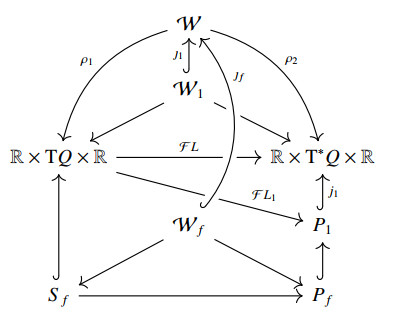











 DownLoad:
DownLoad:



